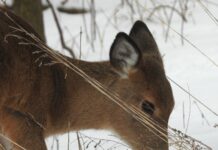Everyone loves box turtles. They are wild, colorful, and familiar. But nature is unkind to them.
Box turtles reproduce slowly, so it’s difficult for populations to grow. They don’t mature until they’re five to ten years old, and then females lay just four or five eggs in a nest she has dug into the ground.
Threats
Raccoons, skunks, opossums and foxes find many nests and devour the eggs. More recently a new deadly threat was discovered — ranavirus. It has been detected in 26 states since 1997, and it infects at least 25 species of turtles and amphibians. Mortality approaches 50 percent. Humans also take a staggering toll.
On highways, road kills are common. Mowing and brush hogging take untold numbers. Railroad tracks trap box turtles between the rails. There they die a slow death due to starvation or dehydration. One study in Virginia surveyed one mile of track for two years and found a dead box turtle every 328 feet. And poachers catch them to sell to the international pet trade.
Optimist
Fortunately, box turtles live 40 to 80 years, so they get many chances to breed. It takes only one successful nest over a lifetime for box turtles to replace themselves. The optimist in me is heartened that over the last 20 years I’ve seen fewer road kills.
Pessimist
The pessimist in me says that’s simply because there are fewer turtles. But when it’s safe to do so, many people now stop when they see a box turtle on the road and help it to the other side. And we now know that box turtles have a strong homing instinct, so we understand that relocating them is usually a death sentence. They will cross roads and highways and expose themselves to predators as they try to find their way “home.”
Box turtles spend their entire lives, which may span 60 or 70 years, on just a few acres. They know every mud hole, hiding place and food patch. If moved to an unfamiliar area, they’re likely to starve or be eaten by predators. If you do take a box turtle home to show the kids, return it to the exact spot you found it within two days. Box turtle courtship is under way and may continue into August.
Fertility
Males and females wander fields and forests and eventually encounter each other. Scent may help males locate females. When a pair meets, the male circles the female, occasionally pushing her and biting her shell. The male overcomes the obvious physical challenge of mating with a concave lower shell and surprising gymnastic ability. During the encounter, the male “stands” upright on the hind tip of his shell. He steadies himself by gripping the female’s shell with his rear feet. Female box turtles can store sperm for up to four years, so she need not find a male every year. However, the fertility of the sperm declines every year.
Shallow nest
A few weeks after mating, females move to open high ground to dig a shallow nest. Using only her hind legs, she digs out a small hole, just two or three inches deep. The sun provides the heat for incubation. The bottom of the flask-shaped nest is wider than the opening at the top. Into the nest she drops four or five white, rubbery inch-long eggs. She then scoops dirt back into the nest and tamps down the soil with her legs and shell. Approximately three months later, depending on soil temperature and moisture, the eggs hatch.
First few years of life
Broods that hatch in October may overwinter in the nest. Turtles that hatch earlier dig their way out of the nest and immediately burrow beneath the leaf litter on the forest floor. Here they spend their first few years of life — hibernating through the winter, eating and growing in the summer. This is why we so rarely see young box turtles less than three inches long. True omnivores, box turtles eat a variety of plants and animals. Strawberries and raspberries, flowers and mushrooms, grasshoppers and crickets, earthworms and salamanders and even carrion satisfy a hungry box turtle. Sounds like the perfect diet for life in the slow lane.













I haven’t seen so many here in South Carolina this year and it is a pity